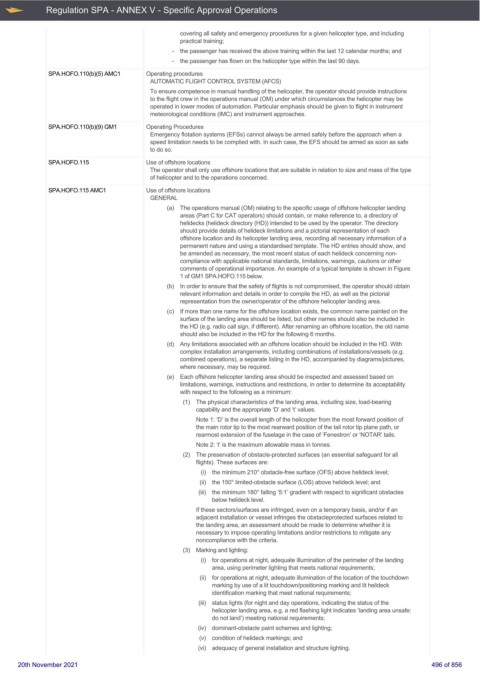Page 496 - UK Air Operations Regulations (Consolidated) 201121
P. 496
~
~ Regulation SPA - ANNEX V - Specific Approval Operations Centrik
covering all safety and emergency procedures for a given helicopter type, and including
practical training;
- the passenger has received the above training within the last 12 calendar months; and
- the passenger has flown on the helicopter type within the last 90 days.
SPA.HOFO.110(b)(5) AMC1 Operating procedures
AUTOMATIC FLIGHT CONTROL SYSTEM (AFCS)
To ensure competence in manual handling of the helicopter, the operator should provide instructions
to the flight crew in the operations manual (OM) under which circumstances the helicopter may be
operated in lower modes of automation. Particular emphasis should be given to flight in instrument
meteorological conditions (IMC) and instrument approaches.
SPA.HOFO.110(b)(9) GM1 Operating Procedures
Emergency flotation systems (EFSs) cannot always be armed safely before the approach when a
speed limitation needs to be complied with. In such case, the EFS should be armed as soon as safe
to do so.
SPA.HOFO.115 Use of offshore locations
The operator shall only use offshore locations that are suitable in relation to size and mass of the type
of helicopter and to the operations concerned.
SPA.HOFO.115 AMC1 Use of offshore locations
GENERAL
(a) The operations manual (OM) relating to the specific usage of offshore helicopter landing
areas (Part C for CAT operators) should contain, or make reference to, a directory of
helidecks (helideck directory (HD)) intended to be used by the operator. The directory
should provide details of helideck limitations and a pictorial representation of each
offshore location and its helicopter landing area, recording all necessary information of a
permanent nature and using a standardised template. The HD entries should show, and
be amended as necessary, the most recent status of each helideck concerning non-
compliance with applicable national standards, limitations, warnings, cautions or other
comments of operational importance. An example of a typical template is shown in Figure
1 of GM1 SPA.HOFO.115 below.
(b) In order to ensure that the safety of flights is not compromised, the operator should obtain
relevant information and details in order to compile the HD, as well as the pictorial
representation from the owner/operator of the offshore helicopter landing area.
(c) If more than one name for the offshore location exists, the common name painted on the
surface of the landing area should be listed, but other names should also be included in
the HD (e.g. radio call sign, if different). After renaming an offshore location, the old name
should also be included in the HD for the following 6 months.
(d) Any limitations associated with an offshore location should be included in the HD. With
complex installation arrangements, including combinations of installations/vessels (e.g.
combined operations), a separate listing in the HD, accompanied by diagrams/pictures,
where necessary, may be required.
(e) Each offshore helicopter landing area should be inspected and assessed based on
limitations, warnings, instructions and restrictions, in order to determine its acceptability
with respect to the following as a minimum:
(1) The physical characteristics of the landing area, including size, load-bearing
capability and the appropriate ‘D’ and ‘t’ values.
Note 1: ‘D’ is the overall length of the helicopter from the most forward position of
the main rotor tip to the most rearward position of the tail rotor tip plane path, or
rearmost extension of the fuselage in the case of ‘Fenestron’ or ‘NOTAR’ tails.
Note 2: ‘t’ is the maximum allowable mass in tonnes.
(2) The preservation of obstacle-protected surfaces (an essential safeguard for all
flights). These surfaces are:
(i) the minimum 210° obstacle-free surface (OFS) above helideck level;
(ii) the 150° limited-obstacle surface (LOS) above helideck level; and
(iii) the minimum 180° falling ‘5:1’ gradient with respect to significant obstacles
below helideck level.
If these sectors/surfaces are infringed, even on a temporary basis, and/or if an
adjacent installation or vessel infringes the obstacleprotected surfaces related to
the landing area, an assessment should be made to determine whether it is
necessary to impose operating limitations and/or restrictions to mitigate any
noncompliance with the criteria.
(3) Marking and lighting:
(i) for operations at night, adequate illumination of the perimeter of the landing
area, using perimeter lighting that meets national requirements;
(ii) for operations at night, adequate illumination of the location of the touchdown
marking by use of a lit touchdown/positioning marking and lit helideck
identification marking that meet national requirements;
(iii) status lights (for night and day operations, indicating the status of the
helicopter landing area, e.g. a red flashing light indicates ‘landing area unsafe:
do not land’) meeting national requirements;
(iv) dominant-obstacle paint schemes and lighting;
(v) condition of helideck markings; and
(vi) adequacy of general installation and structure lighting.
20th November 2021 496 of 856

